PERENNIALS > COLOCASIA > VARIETIES

Elizabeth is a Permaculture Garden Designer, Sustainability Consultant and Professional Writer, working as an advocate for positive change. She graduated from the University of St. Andrews with an MA in English and Philosophy and obtained a Diploma in Applied Permaculture Design from the Permaculture Association.
Reviewed By DAN ORI

Dan has over 27 years’ under his belt caring for plants and gardens. Working as a Horticultural Instructor and Consultant, he draws on a diverse range of experience that includes working as a Head Gardener, Tree Surgeon, Garden Centre Trouble Shooter, and writer of academic papers. Dan has a Level 3 Diploma in Horticulture and is currently a candidate for the RHS’s most prestigious award – The Master of Horticulture.
IN THIS GUIDE
- Choosing The Right Variety
- 1) C. esculenta ‘Black Coral’
- 2) C. esculenta ‘Black Magic’
- 3) C. esculenta ‘Blue Hawaii’
- 4) C. esculenta ‘Burgundy Stem’
- 5) C. esculenta ‘Coal Miner’
- 6) C. esculenta ‘Hawaiian Punch’
- 7) C. esculenta ‘Illustris’
- 8) C. esculenta ‘Cranberry Stem’
- 9) C. esculenta ‘Maui Sunrise’
- 10) C. esculenta ‘Metallica’
- 11) C. esculenta ‘Mojito’
- 12) C. esculenta ‘Pharaoh’s Mask’
- 13) C. esculenta ‘Aloha’
- 14) C. esculenta ‘Diamond Head’
- 15) C. esculenta ‘White Lava’
- References
COLOCASIA GUIDES
Container Growing
Indoors Growing
Propagation
Varieties
Winter Care
There is a wide range of dramatic colocasia varieties which make excellent ornamental garden plants.
Although it is native to much warmer climes, colocasia can be grown outdoors over the summer months in the UK, or grown indoors as a houseplant year-round, as Horticulturist Dan Ori explains:
“Colocasia is a great plant to grow indoors and you can give them a summer holiday in a sheltered spot in the garden in summer.
“They can look spectacular clustered around Cannas and Musa (bananas).”
There is a huge selection of different colours and variations to choose from, which makes these very varied foliage plants.
Choosing The Right Variety
Usually, one factor above all others which will help growers decide which colocasia varieties to grow is the visual appearance of the large leaves and stems.
Of course, you should also look at the size of the colocasia you are considering, and where exactly you plan to grow it.

It can be helpful to think holistically about your plant choices, so consider not only the conditions that this plant needs, and what each cultivar looks like in isolation, but how it will look with other plants in your garden, or as part of your houseplant collection.
To help you decide which of the many colocasia cultivars you would like to add to your collection, here is a list of some of the very best options for UK growers.
Bear in mind that all varieties in this list are H1B hardy and should be grown in a sheltered condition in full sun or part shade.
1) C. esculenta ‘Black Coral’
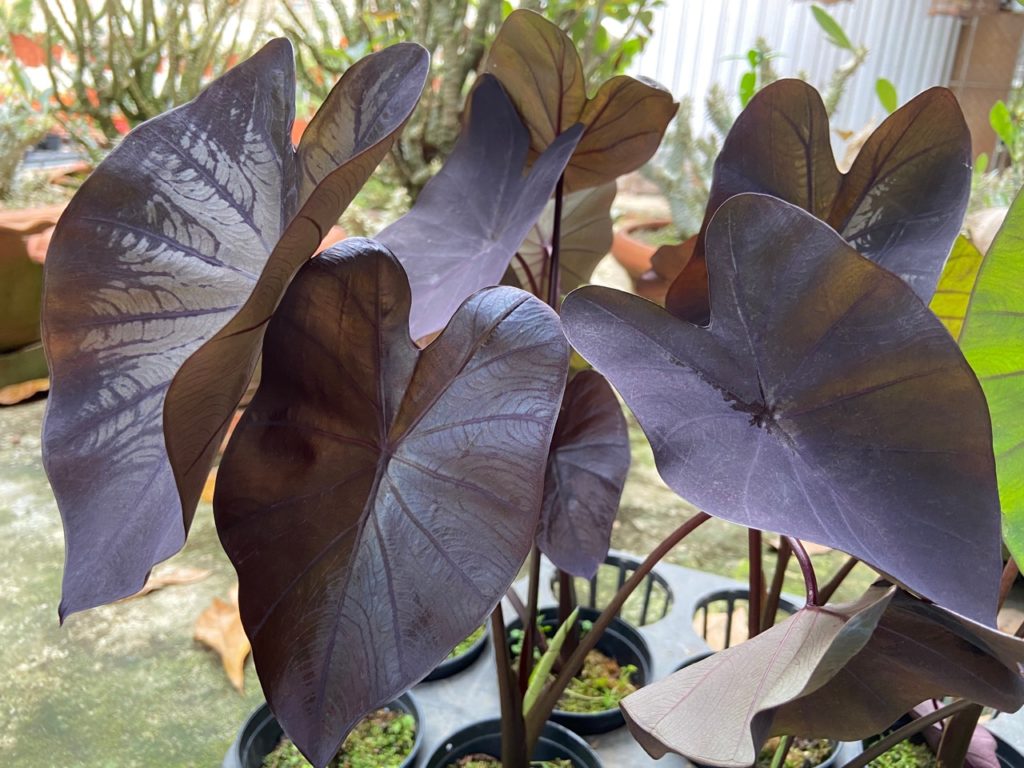
- COMMON NAME(S): Taro ‘Black Coral’
- FOLIAGE: Purple
- STEM: Black
- SOIL PREFERENCE: Loam or sand; any pH
- SIZE: 1-1.5m in height, 0.5-1m spread
This is one of a series of eight colocasias called the ‘Royal Hawaiian’ series, which was introduced by the US company Planthaven.1Colocasia ROYAL HAWAIIAN ‘Black Coral.’ (2022, April 29). PlantHaven International. Retrieved March 14, 2023, from https://planthaven.com/plant/colocasia-black-coral/
It has deep purple-black leaves, with purple-blue veins and deep purple-black stems.
2) C. esculenta ‘Black Magic’
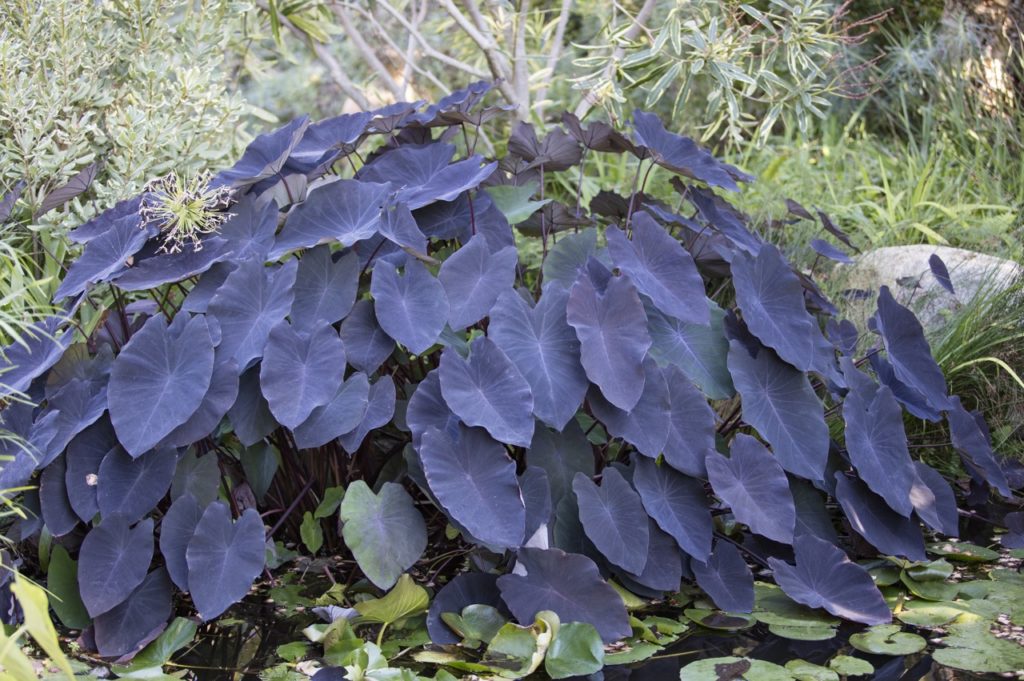
- COMMON NAME(S): Taro ‘Black Magic’
- FOLIAGE: Purple, black and green
- STEM: Black and purple
- FLOWERS: White
- FLOWERING SEASON(S): Summer
- SOIL PREFERENCE: Clay, loam or sand; any pH
- SIZE: 1.5-2.5m in height, 1-1.5m spread
The heart-shaped leaves of this colocasia variety are green when they first emerge, then turn a deep purple over time.
These 60cm long leaves are held on stems of a deep blackish-purple hue.
3) C. esculenta ‘Blue Hawaii’

- COMMON NAME(S): Taro ‘Blue Hawaii’
- FOLIAGE: Green
- STEM: Purple
- SOIL PREFERENCE: Loam or clay; any pH
- SIZE: 1-1.5m in height, 0.5-1m spread
This variety has large, light green leaves, with striking purple veins which stand out in sharp contrast, especially when the light shines through.
This is another Royal Hawaiian colocasia.
4) C. esculenta ‘Burgundy Stem’
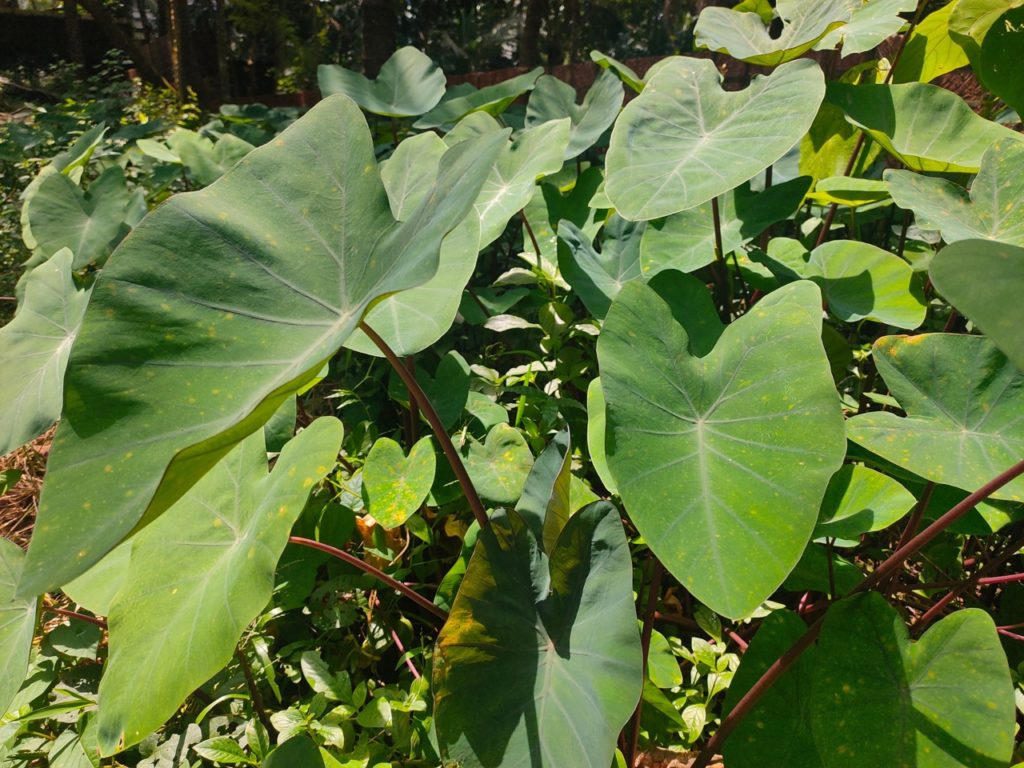
- COMMON NAME(S): Taro ‘Burgundy Stem’
- FOLIAGE: Green
- STEM: Pink and purple
- SOIL PREFERENCE: Loam or clay; any pH
- SIZE: 1-1.5m in height, 0.5-1m spread
As the name suggests, this colocasia has deep, richly coloured burgundy stems, which stand out in contrast to the green leaves and give this plant a very tropical, exotic look.
5) C. esculenta ‘Coal Miner’
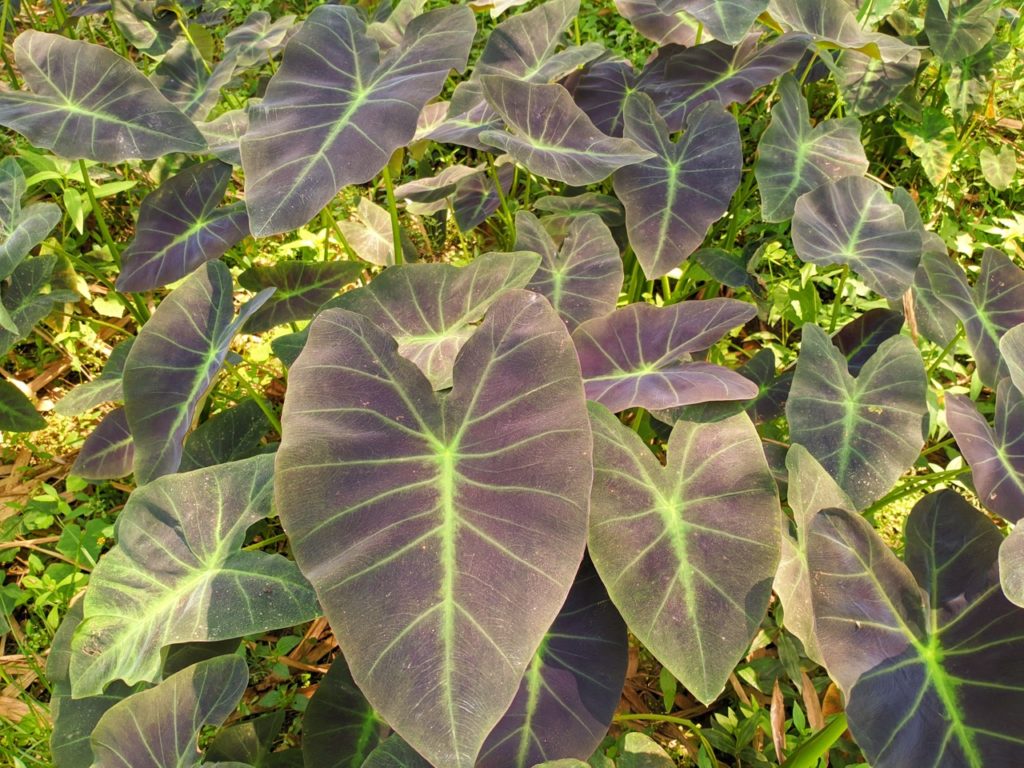
- COMMON NAME(S): Taro ‘Coal Miner’
- FOLIAGE: black and green
- STEM: Black
- SOIL PREFERENCE: Chalk, loam or clay; any pH
- SIZE: 1-1.5m in height, 1-1.5m spread
This colocasia is also aptly named, as the large green leaves are deeply dusted with black as though they have been in a coal mine.
This variety also has black stems, and the deeper greens and blacks of the leaves are punctuated by lighter green veins.
‘Coal Miner’ gets quite tall quite swiftly, and is said to be easy to overwinter successfully in the UK.
6) C. esculenta ‘Hawaiian Punch’

- COMMON NAME(S): Taro ‘Hawaiian Punch’
- FOLIAGE: Green
- STEM: Pink
- SOIL PREFERENCE: Loam or sand; any pH
- SIZE: 1-1.5m in height, 0.5-1m spread
This elephant ear has bright red stems which bring drama and interest to its surroundings and gives the plant an exotic and tropical look.
The stems are very vivid and stand out against the lush, green leaves.
This is another fantastic taro in the Royal Hawaiian series of colocasia.
7) C. esculenta ‘Illustris’
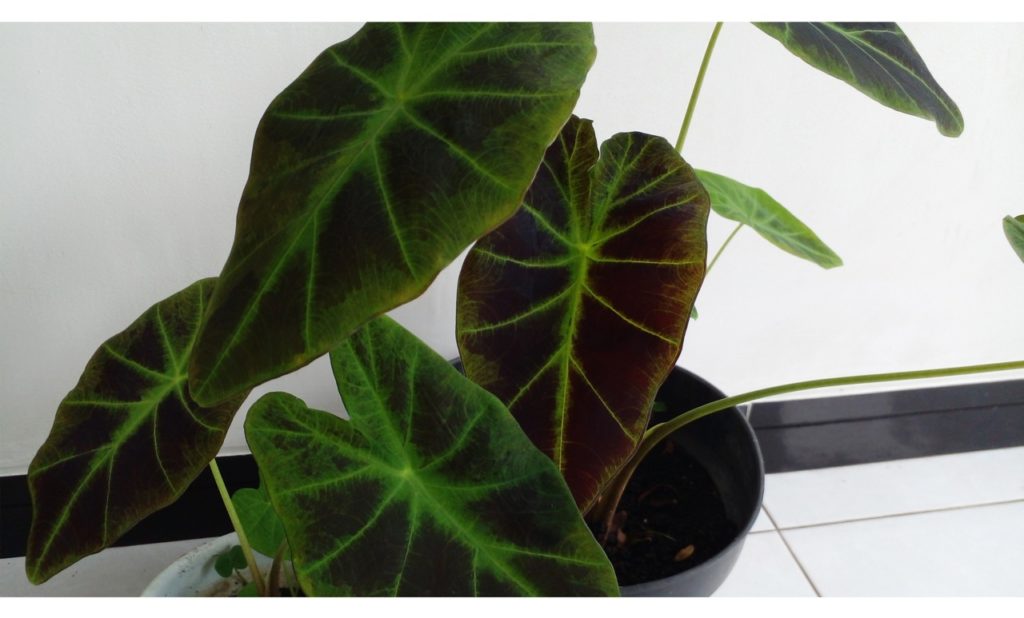
- COMMON NAME(S): Black caladium
- FOLIAGE: Purple and green
- SOIL PREFERENCE: Loam or sand; any pH
- SIZE: 1-1.5m in height, 0.5-1m spread
This is another dramatic and attractive cultivar, which has large elephant ear-like leaves with a deep, russet bronze hue, and lime-green veins which stand out starkly against the rusty backdrop.
8) C. esculenta ‘Cranberry Stem’

- COMMON NAME(S): Taro ‘Cranberry Stem’
- FOLIAGE: Green, gold and yellow
- STEM: Cream and white
- SOIL PREFERENCE: Clay; any pH
- SIZE: 0.5-1.5m in height, 0.5-1m spread
‘Cranberry Stem’ has light green leaves and red stalks which can stand out well and look great alongside other darker colocasia cultivars.
9) C. esculenta ‘Maui Sunrise’
- COMMON NAME(S): Taro ‘Maui Sunrise’
- FOLIAGE: Green, cream and white
- STEM: Green
- SOIL PREFERENCE: Loam or clay; any pH
- SIZE: 0.5-1m in height, 0.5-1m spread
This Royal Hawaiian colocasia has glossy deep green leaves, with creamy-white markings and veins.
10) C. esculenta ‘Metallica’
- COMMON NAME(S): Taro ‘Metallica’
- FOLIAGE: Blue, black, green and bronze
- STEM: Black
- SOIL PREFERENCE: Loam or clay; any pH
- SIZE: 1-1.5m in height, 0.5-1m spread
This fairly new type is an unusual variety of colocasia and has velvety, large blue-green leaves with a metallic sheen, born on shiny, dark stems.
11) C. esculenta ‘Mojito’
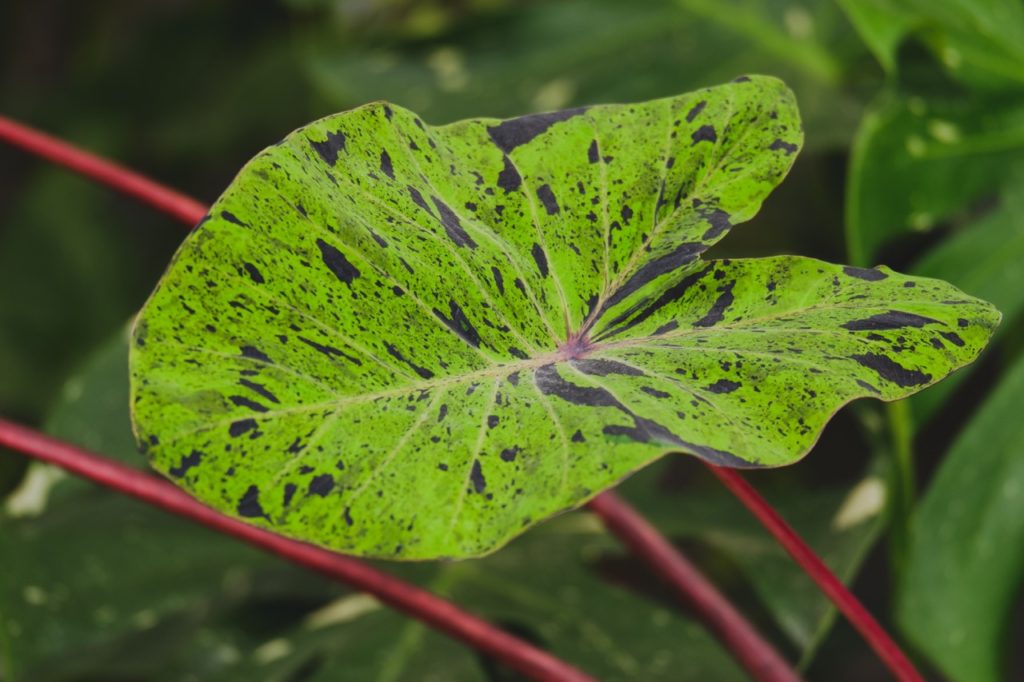
- COMMON NAME(S): Taro ‘Mojito’
- FOLIAGE: Purple and green
- STEM: Purple and red
- SOIL PREFERENCE: Loam or sand; any pH
- SIZE: 1-1.5m in height, 0.5-1m spread
Named after the popular drink, ‘Mojito’ is an introduction from the United States which has chartreuse green foliage, flecked with deep purple and black.
12) C. esculenta ‘Pharaoh’s Mask’

- COMMON NAME(S): Taro ‘Pharaoh’s Mask’
- FOLIAGE: Green and black
- STEM: Black
- SOIL PREFERENCE: Clay; any pH
- SIZE: 1-1.5m in height, 0.5-1m spread
This rare cultivar has deep green heart-shaped leaves, with protruding veins in black, which give it an almost three-dimensional appearance.
The veins begin to flatten and develop over time to give the final mask-like appearance.
This was bred from a mutant form of another varietal called ‘Dark Star’ in the US.
13) C. esculenta ‘Aloha’

- COMMON NAME(S): Taro ‘Aloha’
- FOLIAGE: Purple, black and green
- STEM: Green
- SOIL PREFERENCE: Loam, sand or clay; any pH
- SIZE: 1-1.5m in height, 0.1-0.5m spread
This Royal Hawaiian colocasia has glossy dark purple and dark green leaves, with contrasting light-green veins and light-greenish stems.
14) C. esculenta ‘Diamond Head’

- COMMON NAME(S): Taro ‘Diamond Head’
- FOLIAGE: Purple and black
- STEM: Purple
- SOIL PREFERENCE: Loam, clay or sand; any pH
- SIZE: 1-1.5m in height, 0.5-1m spread
This Royal Hawaiian type of elephant ear has deep purple to black leaves, with a glossy finish, and deep burgundy red stems.
15) C. esculenta ‘White Lava’

- COMMON NAME(S): Taro ‘White lava’
- FOLIAGE: Green, cream and white
- STEM: Purple
- SOIL PREFERENCE: Loam or sand; any pH
- SIZE: 1-1.5m in height, 0.5-1m spread
This colocasia, another in the Royal Hawaiian series, boasts dramatic white-cream flows of ‘lava’ down the centres of the green leaves, radiating out along the veins.
The leaves also each have purple splotches where the leaf attaches to the stalk.
These are, of course, just some of the many colocasia cultivars that you could consider growing either in your garden over the summer or as year-round houseplants here in the UK.
References
- 1Colocasia ROYAL HAWAIIAN ‘Black Coral.’ (2022, April 29). PlantHaven International. Retrieved March 14, 2023, from https://planthaven.com/plant/colocasia-black-coral/

